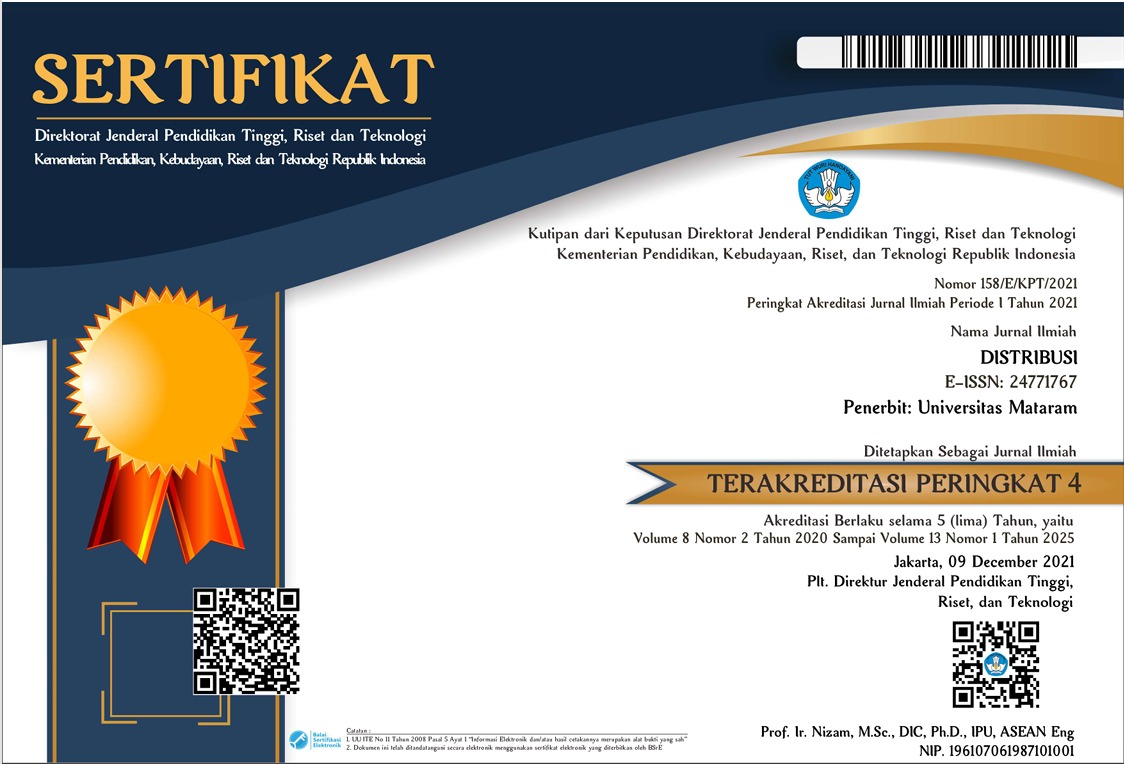CONTRARIAN STRATEGY: EVIDENCE OF PRICE REVERSAL ON WINNER-LOSER PORTFOLIOS
DOI:
https://doi.org/10.29303/distribusi.v12i2.583Keywords:
Contrarian, Indonesia Stock Exchange, Price-Reversal, Winner-Loser StockAbstract
This study aims to analyze the effectiveness of the contrarian strategy by demonstrating the existence of price reversal phenomena in winner-loser stock portfolios on the Indonesia Stock Exchange (IDX). This research differs from previous studies by comprehensively exploring the Indonesian stock market (IDX), which has characteristics distinct from developed countries. Thus, this research contributes new insights to the investment literature in emerging markets. The research approach is quantitative, utilizing monthly data in the form of stock closing prices from all companies listed on the IDX from January 2020 to June 2023, totaling 866 companies, with a selected sample of 670 companies. The hypothesis was tested using an independent sample t-test. The results show that the winner and loser stock portfolios experienced price reversal in the first month after the formation period. However, in the second and third months, the winner stock portfolio did not experience a price reversal but showed significant changes. Meanwhile, the loser stock portfolio experienced price reversals in the first, second, and third months after the formation period. Both portfolios exhibit significant differences in AAR and CAAR values, leading to the general conclusion that price reversal symmetry occurred. Such conditions present opportunities for investors or traders, serving as signals to make contrarian decisions buying loser stocks or selling winner stocks. This phenomenon also provides evidence of the winner-loser anomaly in the Indonesian capital market.
Downloads
References
Anggraeni, I. S. K. (2020). Anomali Overreaction Hypothesis di Bursa Efek Indonesia. Research Fair Unisri, 4(1).
Ball, R., & Kothari, S. P. (1995). Problems in measuring portfolio performance An application to contrarian investment strategies. Journal of Financial Economics, 38(1), 79–107.
Balvers, R., Wu, Y., & Gilliland, E. (2000). Mean Reversion across National Stock Markets and Parametric Contrarian Investment Strategies. The Journal of Finance, LV(2), 745–772.
Chang, R. P., McLeavey, D. W., & Rhee, S. G. (1995). Short‐term abnormal returns of the contrarian strategy in the Japanese stock market. Journal of Business Finance & Accounting, 22(7), 1035-1048.
Chopra, N., Lakonishok, J., & Ritter, J. R. (1992). Measuring abnormal performance: do stocks overreact? The Journal of Finance, 31(2), 235-268.
Conrad, J., Cooper, M., & Kaul, G. (2003). Value versus glamour. The Journal of Finance, 58(5), 1969–1995.
De Bondt, W. F., & Thaler, R. (1985). Does the stock market overreact? The Journal of Finance, 40(3), 793-805.
De Haan, L., & Kakes, J. (2011). Momentum or contrarian investment strategies: evidence from Dutch institutional investors. Journal of Banking & Finance, 35(9), 2245-2251.
Dechow, P. M., & Sloan, R. G. (1997). Returns to contrarian investment strategies : Tests of nqtive expectations hypotheses. J. Journal of Financial Economics, 43(3), 3-27.
Dessaint, O., & Matray, A. (2017). Do managers overreact to salient risks? Evidence from hurricane strikes. Journal of Financial Economics, 126(1), 97-121.
Drehmann, M., & Oechssler, J., & Roider, A. (. (2005). Herding and Contrarian Behavior in Financial Markets - An Internet Experiment Herding and Contrarian Behavior in Financial Markets - An Internet Experiment. American Economic Review.
Goetzmann, W. N. (2002). Daily momentum and contrarian behavior of index fund investors. Journal of Financial and Quantitative Analysis, 37(3), 375–389.
Jiang, X., & Zaman, M. A. (2010). Aggregate insider trading: Contrarian beliefs or superior information? Journal of Banking & Finance, 34(6), 1225-1236.
Jones, C. P. (2014). Investments Analysis and Management (20th ed.). John Wiley & Sons Singapore Pte, Ltd.
Jones, S. (1993). Another look at time-varying and return in a long-horizon contrarian strategy. Journal of Financial Economics, 33(1), 119–144.
Kryzanowski, L., & Zhang, H. (1992). The contrarian investment strategy does not work in Canadian markets. Journal of Financial and Quantitative Analysis, 27(3), 383-395.
Lakonishok, J., Shleifer, A., & Vishny, R. W. (1993). Contrarian investment, extrapolation, and risk. The Journal of Finance, 49(5), 1541–1578.
Lof, M. (2015). Rational speculators, contrarians, and excess volatility. Management Science, 61(8), 1889-1901.
Park, A., & Sabourian, H. (2011). Herding and contrarian behavior in financial markets. Econometrica, 79(4), 973-1026.
Piotroski, J. D., & Roulstone, D. T. (2005). Do insider trades reflect both contrarian beliefs and superior knowledge about future cash flow realizations ? Journal of Accounting and Economics, 39(1), 55-81.
Santosa, P. W., & Santoso, P. W. (2019). Does exchange rate volatility cause overreaction in the capital market? evidence from indonesia. International Journal of Finance and Accounting, 8(3), 80-87.
Shefrin, H. (2000). Beyond Greed and Fear : Understanding Behavioral Finance and the Psychology of Investing. Harvard Business School Press.
Shi, H. L., Jiang, Z. Q., & Zhou, W. X. (2015). Profitability of contrarian strategies in the Chinese stock market. PloS One, 10(9).
Wei, K. D., Wermers, R., & Yao, T. (2015). Uncommon value: The characteristics and investment performance of contrarian funds. Management Science, 61(10), 2394-2414.
Woodside, A. G. (2014). Embrace perform model: Complexity theory, contrarian case analysis, and multiple realities. Journal of Business Research, 67(12), 2495-2503.
Yao, Y. (2012). Momentum, contrarian, and the January seasonality. Journal of Banking & Finance, 36(10), 2757-2769.
Young, A. (1994). Lessons from the East Asian NICs_ A contrarian view. European economic review. European Economic Review, 38(3–4), 964-973.
Zarowin, P. (1985). Does the stock market overreact to corporate earnings information? The Journal of Finance, 44(5), 1385-1399.
Downloads
Published
How to Cite
Issue
Section
License
Copyright (c) 2024 Iwan Kusmayadi, Djoko Suprayetno, Laila Wardani, Zainal Abidin, Muhammad Ahyar

This work is licensed under a Creative Commons Attribution-ShareAlike 4.0 International License.
Penulis yang naskahnya diterbitkan menyetujui ketentuan sebagai berikut:
- Hak publikasi atas semua materi naskah jurnal yang diterbitkan/dipublikasikan dalam situs Jurnal DISTRIBUSI ini dipegang oleh dewan redaksi dengan sepengetahuan penulis (hak moral tetap milik penulis naskah).
- Ketentuan legal formal untuk akses artikel digital jurnal elektronik ini tunduk pada ketentuan lisensi Creative Commons Attribution-ShareAlike (CC BY-SA), yang berarti Jurnal DISTRIBUSI berhak menyimpan, mengalih media/format-kan, mengelola dalam bentuk pangkalan data (database), merawat, dan mempublikasikan artikel tanpa meminta izin dari Penulis selama tetap mencantumkan nama Penulis sebagai pemilik Hak Cipta.
- Naskah yang diterbitkan/dipublikasikan secara cetak dan elektronik bersifat open access untuk tujuan pendidikan, penelitian, dan perpustakaan. Selain tujuan tersebut, dewan redaksi tidak bertanggung jawab atas pelanggaran terhadap hukum hak cipta.









